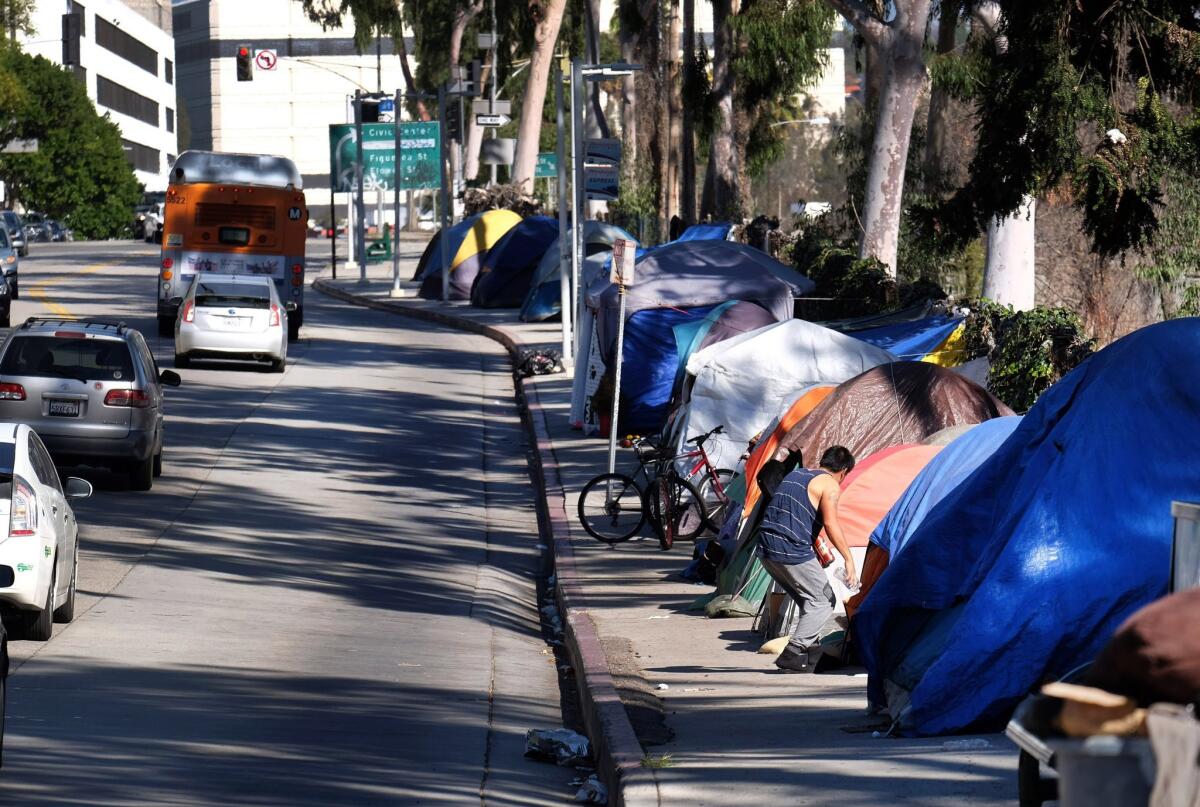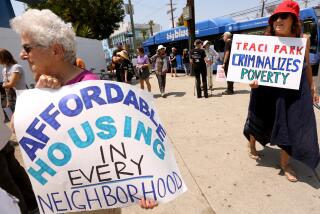Opinion: L.A. should ask its homeless population what would be better than sleeping on the streets

On Monday, a conservative U.S. Supreme Court left standing the simple ruling of lower federal courts that “as long as there is no option of sleeping indoors, the government cannot criminalize indigent, homeless people for sleeping outdoors, on public property, on the false premise they had a choice in the matter.” Those who had hoped that the court would free local governments to rely entirely on the police to clear our sidewalks and underpasses now have one of two choices.
They can go back to using the police to move homeless people from one place to another, which is all the police were ever able to do, so long as they had no answer to the question they were often asked, “Where do you want me to go?”
Or they can make an effort to provide alternatives to street encampments that are actually better — better from the perspectives of unhoused people, not from the viewpoint of bureaucrats and politician or advocates and academics.
We already know from decades of experience and studies that, if given a choice, nearly all homeless people prefer and will accept housing of even the most minimal sort. But Los Angeles is very far from being able to provide that option to more than a small fraction of those now on the streets. While we struggle to provide cheaper housing and the means to afford it, there is only a range of second-best options, the details of which can matter greatly.
For example, Los Angeles offers additional emergency overnight shelter to individuals in the cold and rainy season. Many of those shelters have a significant vacancy rate. People who have neither been homeless nor talked to an unhoused individual often assume that vacancies are the result of “shelter resistance.”
But consider that many of these shelters limit the possessions a person can bring with them to one cubic foot. They must leave everything else on the street. The next day, they must line up again for a chance at a shelter bed, perhaps having lost most everything they owned the night before. They may have also been forced to abandon a pet and separate from someone they love simply to get one night of sleep indoors. In that light, a decision to refuse shelter seems much more reasonable.
When offered an alternative that is better than sleeping on the streets, most people do not require encouragement from a police officer.
To provide a better alternative, however, we have to ask unhoused people what they see as better. That needs to be done in a systematic way. Remarkably, no such information has ever been collected in Los Angeles County.
Los Angeles County has already spent more than $1 billion in sales tax money on its multifaceted homelessness initiative, according to data on the Los Angeles County Homeless Initiative website, and paid its director more than $1 million without seeking any systematic input from those who would benefit — homeless people. The city of Los Angeles is also well on its way to spending $1.2 billion on permanent supportive housing, also without significant input from those who may live in it.
This homelessness information gap needs to be filled. If the city and county don’t want to do it, for whatever reason, then local universities, foundations and charities should step up.
Estimates vary on the number of homeless people in Los Angeles County, but on the low end the county has 44,000 unsheltered homeless people, most of them living on the streets in encampments. Whether or not we transform our shelter system by incorporating the views of those who may use it, there is no scenario in which we can provide 44,000 beds in the immediate future. That means we will have street encampments and people living in their cars for some time to come.
But again, we can improve the situation by incorporating the ideas and needs of those living on the streets. For example, one of the first things people in an encampment will tell you that they need is a place to put trash. As one homeless person told a former student of mine: Before they send the police and dump trucks, could they maybe drop off a dumpster so we can clean up this place ourselves?
Other obvious and often-mentioned needs are basic sanitation facilities and clean water. In other words, the most basic infrastructure any civilization should provide. Many in the homeless population also would probably advocate for voluntary access to an organized campground or safe parking area. But, as with the emergency cold weather shelters, the details will matter.
But to find out what unhoused people think, we have to ask.
Gary Blasi is a professor emeritus of law at UCLA and a former president of the National Coalition for the Homeless.
More to Read
A cure for the common opinion
Get thought-provoking perspectives with our weekly newsletter.
You may occasionally receive promotional content from the Los Angeles Times.










